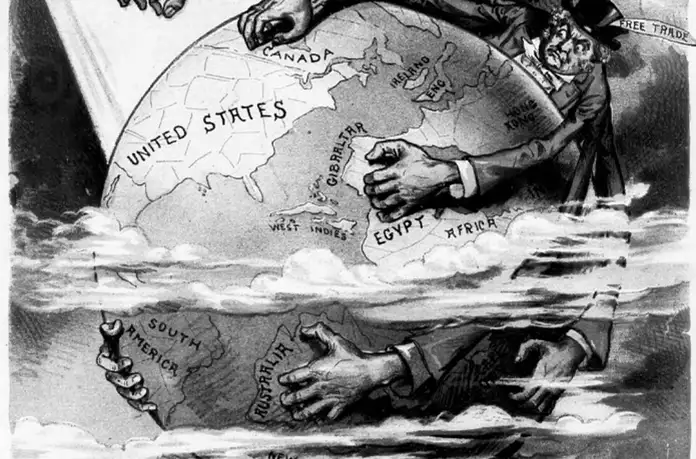- Escalation then de-escalation was the theme last week, and markets whipsawed. Reciprocal tariffs have been partially rolled back as countries negotiate. But China has been singled out
- When we find ourselves in unprecedented times, we like to talk through the risks. Downside risks dominate, requiring more accommodative interest rate settings. But even the most optimistic of scenarios demands an RBNZ cash rate below 3%.
- Financial markets were incredibly volatile. Risk assets were dumped and refuge sought – but not in the traditional places. See our Chart of the Week for more on the market mayhem.
The market mayhem continues as Trump’s stance on tariffs changes by the day. Just one week after imposing the largest trade barriers in over a century, Trump announced on Thursday a 90-day pause on reciprocal tariffs—excluding the blanket 10%—for all countries except China. In the escalating tit-for-tat trade war between China and the US, Chinese imports into the US now face a 145% tariff. While American export goods have been hit by a 125% tariff in return. However, pivoting back, it was announced over the weekend that a wide range of electronics – including smartphones, computers, semiconductors, and other devices – would be exempt. And times are changing.
When we find ourselves in unprecedented times, we consider the risks. We have a set of forecasts, all of which can be blown out of the water by recent events. So, what are the risks to the upside, and downside???
Our “upside” scenario is not much better than our central scenario. Damage has been done, and we’re hopeful Trump will deliver “deals”. The upside scenario is called “deals done, move on”. If we get a permanent pivot from Trump, that’s ‘good’ news. But time is of the essence. Trump may pull off some super-fast negotiations and move on to the next thing. Market uncertainty would end. And we’re left calculating the damage to the global economy, which would be significant but not severe.
Maybe we get 10% tariffs (or close to 10%) across the board, excluding China and the EU. It is hard to think of a scenario where China is not hurt, given the retaliations against the US. The same can be said for the EU. Negotiations could see tariffs on some goods, not others. Because Trump has already announced no (or reduced) tariffs on Chinese electronics (Trump must have seen the numerous articles pointing to the new cost of the iPhone…). No matter where the tariffs fall, there will be a ‘supply’ impact on the price, and therefore a reduction in demand. Amazon reacted immediately, by cancelling orders. Those goods need to find a home. And we may see some goods headed to NZ at a discount. Our upside scenario is a terms of trade shock, but not a bad one. Despite the partial rollback of tariffs, China’s economy is still hit harder than the US economy. The EU is also restrained. And the second-round effects shave a chunk off global growth.
Even the most optimistic outlook demands an RBNZ cash rate below 3%. The need to stimulate with a terms of trade shock is obvious. Our forecast 2.5% cash rate is still required, even if we get nothing but good news from here.
Our central scenario takes more time. We factor in much more time to negotiate. We’re talking months not weeks. And it’s all about getting counties to the table, one by one. Trump has proudly touted that 75 countries have fallen at the feet of the US, and are prepared to kiss the ring of the US emperor. China will neither bend a knee nor kiss a ring. And we doubt the EU will either. There’s bad blood here.
Our central view has much lower than all initially stated reciprocal tariffs. 75 countries could get a deal, closer to 10%. The prolonged negotiations leave the global economy in a heightened sense of insecurity. And volatility continues in all markets. Global growth is significantly lower, and the terms of trade shock hits NZ indirectly. Our central scenario demands a more stimulatory monetary policy setting. A move to 2.5% by the RBNZ occurs much faster, and opens us up to a move to 2%, if required.
Special Topic: The downside scenario
Our downside scenarios are much worse. Reciprocal tariffs come back on close to the initial announcement, with poor negotiating between US, China and others, namely the EU. China and the US find new ways to hurt each other. And both economies are hit hard by the actions of each administration. Trade negotiations take a lot longer to settle, forcing central banks to intervene with financial market dysfunction. Money printing to buy bonds, and possibly other assets, is required to appease frightened investors. And the longer it takes, the worse it gets. There are thousands of ways in which downside scenarios could play out. And the downside risks come with uncomfortably high probabilities. All downside risks end up with materially lower US, Chinese and European growth. Global growth is slashed. The terms of trade shock faced by New Zealand is enough to push the economy back into recession. The RBNZ may be forced to join other central banks in providing a buyer of last resort, especially for Government bonds. It’s possibly a need for QE again. And the cash rate, well, the cash rate of 3.5% needs to be halved, asap. We could easily see the cash rate headed towards 1.5% or lower.
In short, we think our central scenario, with a hint of upside, is the most likely outcome. But the downside risks are heavy and hard to ignore.
From a trading perspective, we would remain in bonds (long). If the central scenario, or upside scenario, play out, we could see a relief run higher in rates. But we still believe a cash rate of 2.5% is required… at a minimum. So, any push higher is likely to meet resistance. And then there are the downside risks. At best, a cash rate of 2% could be reached. At worst, we the bottom could be very deep. A cash rate of 1.5% could quickly become in focus… and there’s still plenty of room to cut from there. We don’t expect this, but it is well within the realms of possibility.
Financial Markets
The comments below were provided by Kiwibank traders. Trader comments may not reflect the view of the research team.
In rates, the fallout from liberation day continues to spread
“The fallout from liberation day continued to spread across markets last week. Worryingly, the market for US treasuries was no shelter with a noticeable absence of a flight to quality. Rather a move away from treasuries has resulted in a surge in the benchmark 10-year yield to around 4.50% and an even more stark cheapening on a swap spread basis. Several reasons have been floated as potential drivers of this move including an unwinding of basis trades or potentially China selling its Treasuries or simply a general sell-America sentiment by investors.
The announcement of a 90-day pause was greeted with relief by the market, though given the share of imports coming from China the net result of the changes actually results in a higher average tariff for goods imported into the US. Though presumably the main takeaway for markets from the pause is the readiness to negotiate and roll back tariffs rather than the absolute level.
New Zealand has mostly been a passenger on this ride, our curve steepening 30bps and swap spreads on government bonds cheapening around 10bps. RBNZ came out mildly dovish, opting to wait for more time to assess the impact of Trump’s tariffs. Though interestingly they see tariffs as a downside risk for both growth and inflation. The short end rallied sharply last week with a terminal OCR now down to 2.65%.
Domestically, we have inflation on Thursday to look forward to this week with a refreshed and reweighted basket of goods.” Matthew Crowder, Balance Sheet Manager – Treasury
In currencies, risk sentiment continues to churn
“Risk on/risk off/risk on: It’s pretty hard to keep up. Last week was another roller coaster ride for currencies, with the Kiwi dollar trading between 0.5486 and 0.5840, depending on the mood. Overall though, the take out of last week was a tentative breather, following the pause that Trump put on the so called ‘reciprocal’ tariffs, reducing it back down to a blanket 10% for the majority of countries. The 90 days breathing space will allow time for countries to negotiate a better deal (in theory). The European Union showed some good faith towards the US, by putting their own retaliatory tariffs on the US on hold for 90 days. The ‘global pause’ gave financial markets a bit of a breather, and saw a dubious risk on sentiment come into play. The Kiwi dollar performed well on the news, trading up to a high of 0.5840 on Friday, then settling at 0.5825 to close the week. This has been preceded of course by a massive risk off theme. Prior to the pause, the focus was on the China/US trade war escalation, which is still very much in play. With China now assigning various tariffs and restrictions on an array of US goods, it is not looking likely that the US Administration will relent on the eye watering 145% tariff rate applicable on China. Things may get uglier from here. On Friday there was talk on the news wires that China might be selling US treasuries in retaliation. But there was also some positive news, that China’s officials would be meeting to discuss a stimulus package to help shore up the Chinese economy. In the week ahead, we have some central bank policy decisions, and NZ’s CPI for Q1. We expect that there will be further volatility this week, although the risk on theme may carry through for a brief period, which will support the Kiwi for now.” Mieneke Perniskie, Trader - Financial Markets.
Weekly Calendar
- It’s a big week for inflation data, with releases due from the UK, Eurozone, Japan, and ourselves. Come Thursday, we expect to see that domestic prices rose 0.8% over the March quarter, nudging the annual rate up to 2.4% (in line with the RBNZ’s forecasts). The slight acceleration is mainly driven by a rebound in tradables inflation, which we expect rose from -1.1% to 0.3% over the year. Higher petrol and food prices lead the move. But there is some offset with seasonally weak airfares. Meanwhile, we expect non-tradables inflation to ease, falling from 4.5% to 3.7% year-on-year.
- Driven by concerns over falling inflation and slower economic growth, there are growing expectations that the European Central Bank will deliver a 25 basis point rate cut at its meeting on Thursday. This follows a notably hawkish cut in February, which had suggested a potential pause in April, as policymakers noted that monetary policy had become "meaningfully less restrictive." However, in the wake of Liberation Day aftermath, market sentiment has shifted, and expectations for further action from the ECB have intensified.
- Thursday will also see the release of Aussie Jobs data for March. Following a much larger than expected loss of 52.8k jobs over February, a slight rebound in job growth is expected. Still, despite the expected pick up in job growth, there’s scope to see a higher unemployment rate come Thursday with labour supply still likely to outpace employment growth. It should be noted however that monthly employment data can be highly volatile.
See our Weekly Calendar for more data releases and economic events this week.
All content is general commentary, research and information only and isn’t financial or investment advice. This information doesn’t take into account your objectives, financial situation or needs, and its contents shouldn’t be relied on or used as a basis for entering into any products described in it. The views expressed are those of the authors and are based on information reasonably believed but not warranted to be or remain correct. Any views or information, while given in good faith, aren’t necessarily the views of Kiwibank Limited and are given with an express disclaimer of responsibility. Except where contrary to law, Kiwibank and its related entities aren’t liable for the information and no right of action shall arise or can be taken against any of the authors, Kiwibank Limited or its employees either directly or indirectly as a result of any views expressed from this information.



